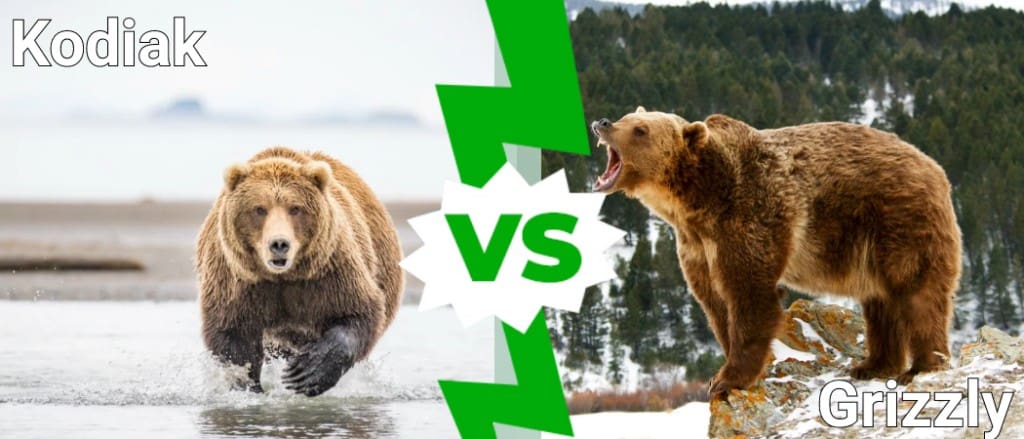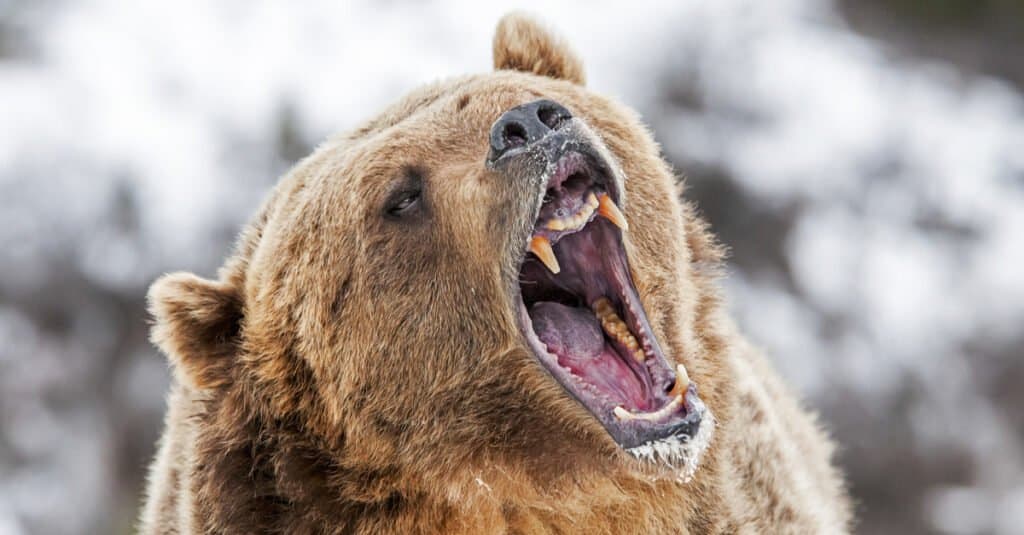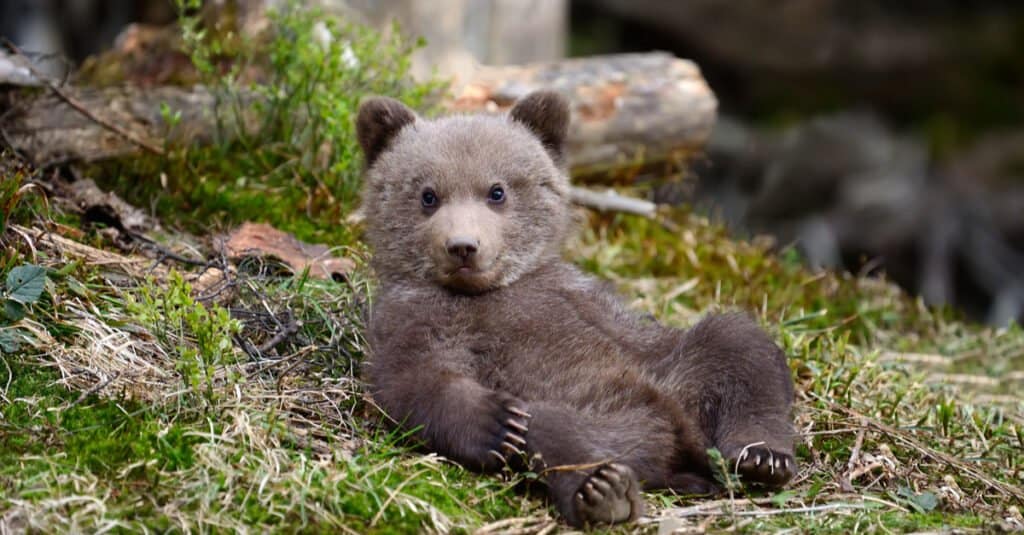Key Points
- While grizzly bears are located throughout most of Alaska and the Western region of the United States and Canada, Kodiak bears are only found in the Kodiak Archipelago in Alaska.
- Kodiak bears are larger in size than grizzlies due to their exclusive location, making them the second largest bear in the world, only smaller than the polar bear.
- Grizzly bears live in a variety of environments like tundras, wetlands, and forests. Kodiak bears only live in the spruce forests and mountain areas of the Kodiak region.
Comparing different types of bears can be difficult, especially a Kodiak vs grizzly bear. These two bears are technically of the same species, commonly known as the brown bear. However, both Kodiak and grizzly bears are subspecies of this branch of animal, and Kodiak bears have made a name for themselves given their geographical location.
But in what other ways are these bears different? And how can you learn how to tell them apart? In this article, we will go over all of these differences in detail so that you can learn the specifics about both Kodiak and grizzlies. Let’s get started and talk about them now.
Comparing Kodiak vs Grizzly

| Kodiak | Grizzly | |
|---|---|---|
| Subspecies | Ursus arctos middendorff | Ursus arctos horribilis |
| Location | Kodiak Archipelago in Alaska | Northwestern Canadian locations and some northern US states, such as Alaska |
| Habitat | Spruce forests and mountains unique to the Kodiak region | Tundras, wetlands, forested areas |
| Appearance | Larger boned and bigger in size than grizzlies, but similar in color | Smaller than Kodiak bears, but similarly tan or brown in color |
| Size and Weight | 8-10 feet tall; over 1500 pounds | 5-8 feet tall; up to 1200 pounds |
The Main Differences Between Kodiak vs Grizzly

You will not find Kodiak bears anywhere else in the world besides the Kodiak Archipelago in Alaska, while grizzly bears are found in many other locations.
©ovbelov/Shutterstock.com
There are many differences between Kodiak vs grizzly bears, particularly in the locations they are found. Kodiak bears are exclusively found in the Kodiak Archipelago in Alaska, while grizzly bears are found everywhere else in Alaska, along with other United States locations and Canada. Because of their special geographical location, Kodiak bears are larger than grizzlies after decades of living in isolation.
Let’s discuss some of these differences in more detail.
Kodiak vs Grizzly: Location Found
The primary difference between a Kodiak vs grizzly bear is the location in which they are found. You will not find Kodiak bears anywhere else in the world besides the Kodiak Archipelago in Alaska, while grizzly bears are found in many other locations. Let’s talk more about these specific geographical locations now.
Kodiak bears live in relative isolation and safety on the Kodiak Archipelago, and thus they have bred and essentially taken over this area. For example, a study shows that there is an estimated 1-2 bears per 0.6 square mile on the island, which is significantly more than you might think! These bears are completely separated from the standard grizzly, and therefore are considered their own subspecies.
Grizzly bears are located in a few United States locations, like Alaska, parts of Wyoming, and other northern states like Montana, Idaho, and Washington. They are also located in parts of Canada, but the majority of grizzly bears are located in Alaska. This is how the Kodiak bears came to reside on the Kodiak Archipelago in the first place!

While grizzly bears were thought to be the largest bear other than
polar bears
, Kodiak bears beat out grizzly bears in both size and weight.
©iStock.com/Jess Bray
Kodiak vs Grizzly: Size and Weight
Another key difference between Kodiak bears and grizzly bears is their overall size and weight differences. While grizzly bears were thought to be the largest bear other than polar bears, Kodiak bears beat out grizzly bears in both size and weight. Let’s talk about this in more detail and why this might be.
Given the relative isolation of the Kodiak Archipelago, Kodiak bears have the opportunity to spread out and grow larger. These bears are notoriously larger and heavier than grizzly bears, making them the second largest bear other than polar bears. The average Kodiak grows over 1500 pounds and stands anywhere from eight to 10 feet tall. The average grizzly tends to weigh up to 1200 pounds and only stands at 5 to 8 feet tall.
While that’s nothing to scoff at, there is a huge difference when comparing the size and weight of a Kodiak vs grizzly. It is especially outstanding given that these two bears were once the same species, but Kodiaks have evolved to suit their surroundings.

Given the prevalence of food and lack of poaching or hunting, Kodiak bears eat far more than the average grizzly bear.
©Scott E Read/Shutterstock.com
Kodiak vs Grizzly: Diet and Behavior
When comparing a Kodiak vs grizzly bear, their diet and behavioral differences must be addressed. This is because Kodiak bears have evolved in two different social and dietary structures when compared to that of the grizzly bear, their former species classification. Let’s talk more about some of these differences in detail.
Given the prevalence of food and lack of poaching or hunting, Kodiak bears eat far more than the average grizzly bear. They also have regular access to freshly caught salmon and other fish given their proximity and lack of competition. There are also vast amounts of edible vegetation for these bears to partake of in times when meat is not as abundant.
Grizzly bears also seek salmon, as well as trout and bass from rivers, and they prey upon large mammals when they can find them, including caribou, elk, moose, big horn sheep, bison, and deer. As far as their plant diet goes, depending on the region they live in, grizzlies eat a wide variety of berries, tubers, whitebark pine nuts, and legumes. They will even go for smaller mammals and insects. If food is in abundance, grizzly bears can be known to feed in groups, but generally, competition for food is more fierce among grizzlies than Kodiaks.
Because of their isolation, Kodiak bears have adapted. They formed complicated social structures that have not been observed in other bear species. This is because they understand that their resources should be shared amongst all Kodiak bears. Additionally, these bears simply have less to worry about than the average grizzly bear.

Grizzly bears are located in specific locations, but they are more common than Kodiak bears overall.
©Volodymyr Burdiak/Shutterstock.com
Kodiak vs Grizzly: Endangerment and Rarity
The final difference between Kodiak bears versus grizzly bears is their endangerment and rarity. Grizzly bears are located in specific locations, but they are more common than Kodiak bears overall. Kodiak bears are only found on the Kodiak Archipelago, and it is estimated that 3,500 Kodiak bears exist, total! This is a much smaller number when compared to the estimated 50,000 grizzly bears found throughout North America.
Summary of Kodiak vs. Grizzly Bear
Here’s a summation of how Kodiak and Grizzly bears compare:
| Trait | Kodiak Bear | Grizzly Bear |
|---|---|---|
| Location | Kodiak Peninsula in Alaska | Alaska, Western US and Canada |
| Habitat | Spruce forests and mountains in Kodiak Peninsula | Tundras, wetlands, forests |
| Size | 2nd largest bear in world; 8-10 ft tall; 1500+ pounds | 5-8 ft tall; up to 1200 lbs |
| Diet & Behavior | Diet rich in salmon and vegetation; less competition for resources | Eat many types of mammals, fish, and vegetation; can be territorial due to competition |
| Rarity | 3,500 in Kodiak Peninsula exclusively | 50,000 in Alaska and US/Canadian regions |
How Many Brown Bear Attacks Happen Per Year?

In North America, there were 183 grizzly bear attacks on humans over a 15-year period.
©Jack Nevitt/Shutterstock.com
There’s no denying that both grizzly and Kodiak bears are fearsome animals. Unfortunately, humans can come into danger when they encounter either of these bears in the wild. It may cause you to wonder–how many brown bear attacks happen per year? There are an average of 44 reported grizzly bear attacks worldwide per year.
In North America, there were 183 attacks over a 15-year period, while 291 occurred in Europe and 190 in Asia. From 2015-2022, there were a total of 15 fatalities in North America from grizzly attacks. But Europe leads with an average of 20 fatalities annually.
In over 50% of the cases, humans were engaged in leisure activities such as camping, fishing, hiking, or jogging. One-fourth of the victims of bear attacks were engaged in job-related activities like farming or logging. And 22% of attacks occurred during bear hunts. Data proves that most major bear attacks happen when a human accidentally engages a female grizzly who has cubs.
The photo featured at the top of this post is ©
Thank you for reading! Have some feedback for us? Contact the AZ Animals editorial team.






